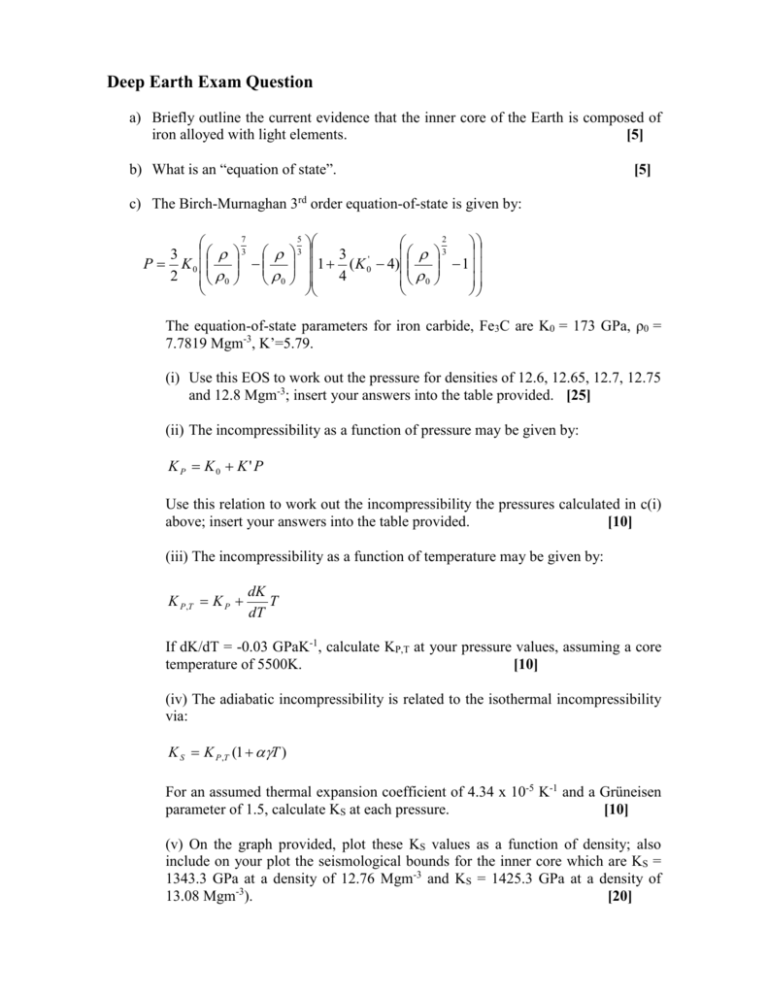Deep Earth Exam Question
advertisement

Deep Earth Exam Question a) Briefly outline the current evidence that the inner core of the Earth is composed of iron alloyed with light elements. [5] b) What is an “equation of state”. [5] c) The Birch-Murnaghan 3rd order equation-of-state is given by: 7 5 2 3 3 3 3 3 ' P K 0 1 ( K 0 4) 1 2 0 0 4 0 The equation-of-state parameters for iron carbide, Fe3C are K0 = 173 GPa, ρ0 = 7.7819 Mgm-3, K’=5.79. (i) Use this EOS to work out the pressure for densities of 12.6, 12.65, 12.7, 12.75 and 12.8 Mgm-3; insert your answers into the table provided. [25] (ii) The incompressibility as a function of pressure may be given by: K P K0 K ' P Use this relation to work out the incompressibility the pressures calculated in c(i) above; insert your answers into the table provided. [10] (iii) The incompressibility as a function of temperature may be given by: K P ,T K P dK T dT If dK/dT = -0.03 GPaK-1, calculate KP,T at your pressure values, assuming a core temperature of 5500K. [10] (iv) The adiabatic incompressibility is related to the isothermal incompressibility via: K S K P ,T (1 T ) For an assumed thermal expansion coefficient of 4.34 x 10-5 K-1 and a Grüneisen parameter of 1.5, calculate KS at each pressure. [10] (v) On the graph provided, plot these KS values as a function of density; also include on your plot the seismological bounds for the inner core which are KS = 1343.3 GPa at a density of 12.76 Mgm-3 and KS = 1425.3 GPa at a density of 13.08 Mgm-3). [20] (vi) (a) On the basis of your plot comment on the likelihood of there being carbon in the inner core; b) what are the major assumptions made in your calculations; c) how this result is affected by these assumptions. [15] Table for part (c): ρ (Mgm-3) 12.6 12.65 12.7 12.75 12.8 P (GPa) KP (GPa) KP,T (GPa) KS (GPa) Graph for part (c): 3000 2800 2600 KS GPa 2400 2200 2000 1800 1600 1400 1200 1000 12.5 12.6 12.7 12.8 12.9 -3 Density Mgm 13 13.1 13.2 Answers: a) from seismology: density < pure Fe therefore light element; cosmochemistry says iron cores have light elements; mineral physics matches light element density with S,Si, C, O as most likely; mineral physics measures solubilities of light elements into Fe. [2,1,1,1] b) relates volume or density to P/T; includes gas law, BM 1-3, logarithmic, universal, Murnaghan, etc.[2, 3@1 for any/each of rest]. c) (i) see below [5@ 5 each] (ii) see below [5@ 2 each] (iii) see below [5@ 2 each] (iv) see below [5@ 2 each] (v) see below [5@ 3 each plus 2@2.5 each] (vi) a) not likely as lines far apart [4] b) assumption in choice of EOS, no use of K’’, neglect of dK/dT as f(P), neglect of dα/dP, neglect of dγ/d(P,T), assumption of core T=5500K [6@ 1 each] c) although the numbers will be different, the effect on the story is probably very little as the effects of P and T will inversely offset each other; the differences in the numbers will be an illustration of the uncertainties [5]. P 331.1487542 337.6408634 344.2106818 350.8586725 357.5852987 rho 12.6 12.65 12.7 12.75 12.8 K (P) 2090.351 2127.941 2165.98 2204.472 2243.419 K(P,T) 1925.351287 1962.940599 2000.979847 2039.471714 2078.41888 Ks 2614.72 2665.77 2717.43 2769.70 2822.60 3000 2800 2600 KS GPa 2400 2200 2000 1800 1600 1400 1200 1000 12.5 12.6 12.7 12.8 12.9 -3 Density Mgm 13 13.1 13.2







